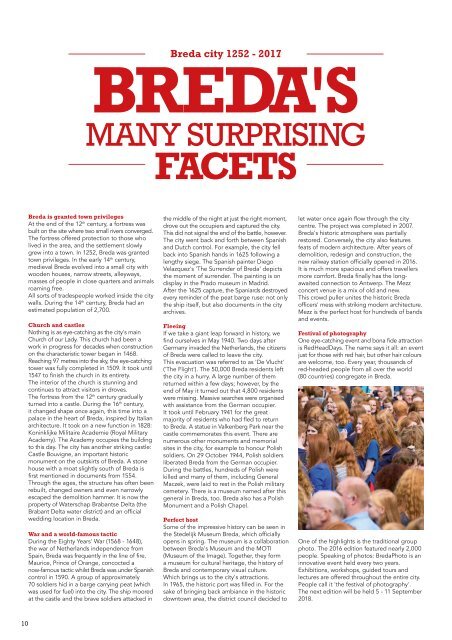Refresh Magazine
You also want an ePaper? Increase the reach of your titles
YUMPU automatically turns print PDFs into web optimized ePapers that Google loves.
Breda city 1252 - 2017<br />
BREDA'S<br />
MANY SURPRISING<br />
FACETS<br />
Breda is granted town privileges<br />
At the end of the 12 th century, a fortress was<br />
built on the site where two small rivers converged.<br />
The fortress offered protection to those who<br />
lived in the area, and the settlement slowly<br />
grew into a town. In 1252, Breda was granted<br />
town privileges. In the early 14 th century,<br />
medieval Breda evolved into a small city with<br />
wooden houses, narrow streets, alleyways,<br />
masses of people in close quarters and animals<br />
roaming free.<br />
All sorts of tradespeople worked inside the city<br />
walls. During the 14 th century, Breda had an<br />
estimated population of 2,700.<br />
Church and castles<br />
Nothing is as eye-catching as the city's main<br />
Church of our Lady. This church had been a<br />
work in progress for decades when construction<br />
on the characteristic tower began in 1468.<br />
Reaching 97 metres into the sky, the eye-catching<br />
tower was fully completed in 1509. It took until<br />
1547 to finish the church in its entirety.<br />
The interior of the church is stunning and<br />
continues to attract visitors in droves.<br />
The fortress from the 12 th century gradually<br />
turned into a castle. During the 16 th century,<br />
it changed shape once again, this time into a<br />
palace in the heart of Breda, inspired by Italian<br />
architecture. It took on a new function in 1828:<br />
Koninklijke Militaire Academie (Royal Military<br />
Academy). The Academy occupies the building<br />
to this day. The city has another striking castle:<br />
Castle Bouvigne, an important historic<br />
monument on the outskirts of Breda. A stone<br />
house with a moat slightly south of Breda is<br />
first mentioned in documents from 1554.<br />
Through the ages, the structure has often been<br />
rebuilt, changed owners and even narrowly<br />
escaped the demolition hammer. It is now the<br />
property of Waterschap Brabantse Delta (the<br />
Brabant Delta water district) and an official<br />
wedding location in Breda.<br />
War and a world-famous tactic<br />
During the Eighty Years' War (1568 - 1648),<br />
the war of Netherlands independence from<br />
Spain, Breda was frequently in the line of fire.<br />
Maurice, Prince of Orange, concocted a<br />
now-famous tactic whilst Breda was under Spanish<br />
control in 1590. A group of approximately<br />
70 soldiers hid in a barge carrying peat (which<br />
was used for fuel) into the city. The ship moored<br />
at the castle and the brave soldiers attacked in<br />
the middle of the night at just the right moment,<br />
drove out the occupiers and captured the city.<br />
This did not signal the end of the battle, however.<br />
The city went back and forth between Spanish<br />
and Dutch control. For example, the city fell<br />
back into Spanish hands in 1625 following a<br />
lengthy siege. The Spanish painter Diego<br />
Velazquez's 'The Surrender of Breda' depicts<br />
the moment of surrender. The painting is on<br />
display in the Prado museum in Madrid.<br />
After the 1625 capture, the Spaniards destroyed<br />
every reminder of the peat barge ruse: not only<br />
the ship itself, but also documents in the city<br />
archives.<br />
Fleeing<br />
If we take a giant leap forward in history, we<br />
find ourselves in May 1940. Two days after<br />
Germany invaded the Netherlands, the citizens<br />
of Breda were called to leave the city.<br />
This evacuation was referred to as 'De Vlucht'<br />
('The Flight'). The 50,000 Breda residents left<br />
the city in a hurry. A large number of them<br />
returned within a few days; however, by the<br />
end of May it turned out that 4,800 residents<br />
were missing. Massive searches were organised<br />
with assistance from the German occupier.<br />
It took until February 1941 for the great<br />
majority of residents who had fled to return<br />
to Breda. A statue in Valkenberg Park near the<br />
castle commemorates this event. There are<br />
numerous other monuments and memorial<br />
sites in the city, for example to honour Polish<br />
soldiers. On 29 October 1944, Polish soldiers<br />
liberated Breda from the German occupier.<br />
During the battles, hundreds of Polish were<br />
killed and many of them, including General<br />
Maczek, were laid to rest in the Polish military<br />
cemetery. There is a museum named after this<br />
general in Breda, too. Breda also has a Polish<br />
Monument and a Polish Chapel.<br />
Perfect host<br />
Some of the impressive history can be seen in<br />
the Stedelijk Museum Breda, which officially<br />
opens in spring. The museum is a collaboration<br />
between Breda's Museum and the MOTI<br />
(Museum of the Image). Together, they form<br />
a museum for cultural heritage, the history of<br />
Breda and contemporary visual culture.<br />
Which brings us to the city's attractions.<br />
In 1965, the historic port was filled in. For the<br />
sake of bringing back ambiance in the historic<br />
downtown area, the district council decided to<br />
let water once again flow through the city<br />
centre. The project was completed in 2007.<br />
Breda's historic atmosphere was partially<br />
restored. Conversely, the city also features<br />
feats of modern architecture. After years of<br />
demolition, redesign and construction, the<br />
new railway station officially opened in 2016.<br />
It is much more spacious and offers travellers<br />
more comfort. Breda finally has the longawaited<br />
connection to Antwerp. The Mezz<br />
concert venue is a mix of old and new.<br />
This crowd puller unites the historic Breda<br />
officers' mess with striking modern architecture.<br />
Mezz is the perfect host for hundreds of bands<br />
and events.<br />
Festival of photography<br />
One eye-catching event and bona fide attraction<br />
is RedHeadDays. The name says it all: an event<br />
just for those with red hair, but other hair colours<br />
are welcome, too. Every year, thousands of<br />
red-headed people from all over the world<br />
(80 countries) congregate in Breda.<br />
One of the highlights is the traditional group<br />
photo. The 2016 edition featured nearly 2,000<br />
people. Speaking of photos: BredaPhoto is an<br />
innovative event held every two years.<br />
Exhibitions, workshops, guided tours and<br />
lectures are offered throughout the entire city.<br />
People call it 'the festival of photography'.<br />
The next edition will be held 5 - 11 September<br />
2018.<br />
10


















